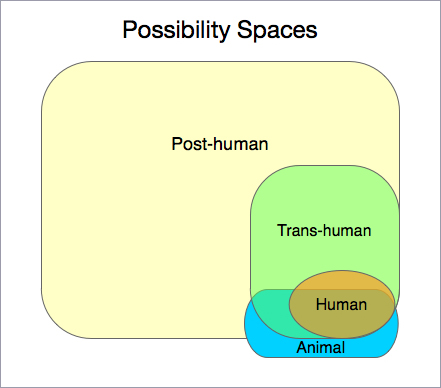For designers at the forefront of user experience, it is easy to see the value of exploring fictions like Synthetic Serendipity. They are tantalizingly close at hand, and every passing day brings the vision closer through a new technology, service, or tangible experience that design touches in some concrete way.
Looking further afield is also important. Our reactions to more speculative and exploratory fictions affect our decisions about the appropriate reach and scope of design in the future. The conversations designers have about such fictions help us solidify both what and how we will design for the coming world of everyware. As designers, the decisions we make today will help decide what humanity is to be tomorrow.
This is not just the view of designers. Many futurist organizations recognize the central role of design—as an approach, method, practice, and community—in shaping the future nature of human experience and humanity. One of the more visible groups that is dedicated to influencing the future is the World Transhumanist Association, recently renamed Humanity+. “The Transhumanist Declaration,” the group’s manifesto, begins:
“Humanity will be radically changed by technology in the future. We foresee the feasibility of redesigning the human condition, including such parameters as the inevitability of aging, limitations on human and artificial intellects, unchosen psychology, suffering, and our confinement to the planet Earth.” [2]
It’s a nuanced declaration. “We foresee the feasibility of…” is hardly definitive, but the central role of design as a leading agent of the transhumanist agenda of technologically driven human improvement is clear. (As with any good manifesto, it is difficult to ignore the ambitious nature of their goals. Speaking for myself, I am not ready to agree humanity should eliminate aging. And I feel even more strongly that it’s not the proper role of design to focus on this aim.)
In their Declaration of Values, the World Transhumanist Association goes even further and sets the creation of evolved “post-humans” as their goal:
“Transhumanists view human nature as a work-in-progress, a half-baked beginning that we can learn to remold in desirable ways. Current humanity need not be the endpoint of evolution. Transhumanists hope that by responsible use of science, technology, and other rational means we shall eventually manage to become posthuman, beings with vastly greater capacities than present human beings have.” [3]
As a description—and thus, a design vision to be realized—“vastly greater capacities” leaves much to the imagination. What would post-humans look like? How would they differ from humans today, and what greater capacities would they have? The most important question for designers interested in everyware is this: “What is the experience of being post-human?”
In reference to the ordinary human experience, as illustrated in Figure 1, transhumanism asserts the following:
“Our own current mode of being, therefore, spans but a minute subspace of what is possible or permitted by the physical constraints of the universe. It is not farfetched to suppose that there are parts of this larger space that represent extremely valuable ways of living, relating, feeling, and thinking.” [3]

What do we gain from making the leap to post-human? According to the World Transhumanist Association’s Declaration of Values, “Transhumanism promotes the quest to develop further so that we can explore hitherto inaccessible realms of value.” [3] In its aim to explore a realm of possibilities that are defined by constraints, the transhuman project is akin to design. One might even say that it depends on design for its successful realization.
Assuming design is central to this quest for enhanced value, we must ask, “What is a post-human?” According to the World Transhumanist Association’s FAQ:
“Posthumans could be completely synthetic artificial intelligences, or they could be enhanced uploads, or they could be the result of making many smaller but cumulatively profound augmentations to a biological human. The latter alternative would probably require either the redesign of the human organism using advanced nanotechnology or its radical enhancement using some combination of technologies such as genetic engineering, psychopharmacology, anti-aging therapies, neural interfaces, advanced information management tools, memory enhancing drugs, wearable computers, and cognitive techniques.” [4]
This description brings us squarely back to the future Dan Simmons envisions in the paired novels Ilium and Olympos. In these novels, Simmons explores the space of post-human possibility by depicting several versions of evolved humanity that neatly parallel the speculations of the World Transhumanist Association. He describes “old-style,” ordinary humans, augmented trans-humans, and true post-humans, who are essentially unrecognizable from our current viewpoint. The novels also feature a race of primarily robotic cyborgs that are endowed with human intelligence and are called moravecs, which the author named after scientist Hans Moravec. [5] Altogether, these humans and cyborgs present degrees of human integration with computing and the larger environment that span a continuum ranging from an emphasis on the human to an emphasis on the machine.
The “Old-Style” Humans
From the perspective of design and everyware, Simmons’s old-style humans, or ordinary people, are interesting primarily for what they cannot do. They cannot interact with the ubiquitous technology and information resources that are deeply integrated into the future environment. In essence, normal people find themselves disenfranchised and passive in the face of advanced technologies that have effectively disappeared from their environments and of which they are largely ignorant.
As a result, the post-humans who create and control these technologies can reduce ordinary people to information and manipulate them as such. At two points in the story, large groups of people suffer involuntary “dematerialization,” being turned into archived data for easy storage and transport. According to transhumanist thinking, “uploading,” in this manner, is one of the common paths for human enhancement using technology. They see uploading as a voluntary way of escaping or exceeding the physical constraints of human life. In Simmons’s fictions, however, uploading happens without the full consent of the people who are affected.
When reversed, this dematerialization does not appear to affect ordinary people in any way. They have no recollection or experience of time while dematerialized. The implications are rather unsettling—that the entire essence of the human experience is information we can easily manipulate using technology, that we can activate and deactivate people at will, and that time itself does not pass while they are deactivated.
The Moravecs
The moravecs are cyborgs with human intelligence and consciousness that post-humans designed to explore the further reaches of the solar system. In terms of the space of post-human possibility, these cyborgs emphasize a machine-like direction in human development. Though varying greatly in their physical structure and size—depending on their different operating environments—all moravecs deliberately include human personality, emotions, and appreciation for aesthetics. By design, the moravecs can interpret and understand human culture, science, engineering, history, art, literature, poetry, and film. They have chosen to retain these human characteristics throughout their self-evolved history.
Among the range of modified or post-human forms Simmons depicts, the artificial and mostly mechanical moravecs, ironically, remain the most recognizably human in terms of their emotion and intellect, by virtue of their ability to appreciate art. Again, the implication—that human personality, emotion, and meaning are fully computable and transferable to non-human forms—is unsettling.
The Post-Humans
The post-humans Simmons describes are the least human-like of the various evolved humans in Ilium and Olympos. As the World Transhumanist Association FAQ suggests, their appearance and behavior are “no longer unambiguously human by our current standards.” [4] Post-human biology and physiology are so different from human norms that they have few recognizable anatomical structures such as organs and bones, though they often manifest human form. Nearly inconceivable knowledge and technology allow post-humans to assume physical forms as they wish, teleport directly from one place to another, and alter the speed and flow of time in some circumstances.
Simmons does not describe post-humans in great detail in Ilium and Olympos, saying they are more like quantum probability phenomena than humans—merely wavefront-based consciousnesses who can manifest and alter the fabric of space and time essentially at will. In his presentation of the post-humans, Simmons parallels the transhumanist perspective, which asserts, “Posthumans might shape themselves and their environment in so many new and profound ways that speculations about the detailed features of posthumans and the posthuman world are likely to fail.” [4]
